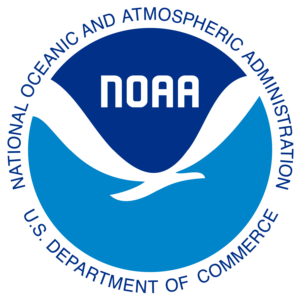
Federal Resources
2016 – 2023 Unusual Mortality Event, Acoustic Activity & Survey Work
As New Jersey advances offshore wind development goals, the New Jersey Department of Environmental Protection will continue to coordinate with the federal agencies responsible for the stewardship of the nation’s ocean resources and their habitat to diligently monitor the ongoing Unusual Mortality Event in the New York/New Jersey Bight.
Orange bars represent strandings during the UME.
Source: NOAA Fisheries

National Oceanic and Atmospheric Administration (NOAA)
“NOAA Fisheries is a science agency, and like our marine mammal stranding network partners, we value marine life and strive to conserve these species. We are dedicated to minimizing risks to protected resources, habitats, and managed fisheries throughout the life cycle of offshore wind energy projects. The agency is responsible for several regulatory processes that help reduce impacts to marine animals and their habitats from human activities, including during offshore wind development.”
NOAA’s Frequent Asked Questions—Offshore Wind and Whales answers questions such as:
- What is the current status of the humpback whale population in the North Atlantic?
- What does NOAA Fisheries do to minimize the impact of offshore wind development on whales?
- Is U.S. offshore wind development linked to any whale deaths?
- Does NOAA Fisheries authorize the death of whales as it relates to offshore wind development?
- What is the cause of recent whale deaths off New York and New Jersey? Is it related to offshore wind development?
- Why is there currently a high number of large whales in the waters off New Jersey?
- Is climate change a factor in the number of whales we’re seeing close to shore?
Humpback Whale Unusual Mortality Event (UME) Along the Atlantic Coast
Since January 2016, elevated humpback whale mortalities have occurred along the Atlantic coast from Maine through Florida. A portion of the whales have shown evidence of pre-mortem vessel strike; however, this finding is not consistent across all whales examined. More research is needed.
As part of the UME investigation process, NOAA assembled an independent team of scientists to coordinate with the Working Group on Marine Mammal Unusual Mortality Events to review data, sample stranded whales, and determine next steps. The investigation is ongoing.

Bureau of Ocean Energy Management (BOEM)
“The Department of the Interior’s Bureau of Ocean Energy Management (BOEM) manages the development of U.S. Outer Continental Shelf (OCS) energy and mineral resources in an environmentally and economically responsible way. The bureau promotes energy independence, environmental protection, and economic development through responsible, science-based management of energy and mineral resources on the OCS.”
BOEM’s Offshore Wind Activities and Marine Mammal Protection answers questions such as:
- How does BOEM ensure that whales are protected from offshore wind leasing and development activities?
- Do offshore wind vessels use seismic airguns for their surveys?
- How do High Resolution Geophysical surveys affect marine mammals?
Protected Measures Conducted During Survey Activity. BOEM requires strict protective measures for when the offshore wind industry conducts activities offshore:
- “Acoustic exclusion zones” which ensures that the zone is clear of any marine mammals and sea turtles for a certain amount of time before acoustic sound sources can be operated.
- Protected Species Observers are trained professionals that look for marine mammals so that the possibility of vessel strikes is minimized and to shut down any sound sources if marine mammals are detected within a certain distance.
- Independent reporting by Protected Species Observers during geophysical surveys. Any interactions with protected species are immediately reported to NOAA Fisheries and BOEM.
Acoustic Activity & Survey Work
High Resolution Geophysical (HRG) surveys assist with siting evaluations conducted by offshore wind development. HRG surveys use a suite of active sound sources to produce sounds that are reflected off subsea structures to obtain images of the seafloor and shallow geophysical features. The sound sources used in HRG surveys are much lower in energy than seismic airguns and have other important characteristics that set them apart from seismic airguns. Scientists from BOEM recently coauthored a scientific paper that describes key physical attributes of HRG sources – such as beamwidth, exposure duration, and frequency – that make them unlikely to result in incidental harassment of marine mammals.
BOEM Study: Categorizing Active Marine Acoustic Sources Based on Their Potential to Affect Marine Animals The study conducted by U.S. Geological Survey, University of New Hampshire, and the Center for Marine Acoustics, Bureau of Ocean Energy Management.
 Marine Mammal Commission
Marine Mammal Commission
The Marine Mammal Commission provides independent, science-based oversight of domestic and international policies and actions of federal agencies addressing human impacts on marine mammals and their ecosystems. The Commission’s mission is largely driven by the Marine Mammal Protection Act (MMPA). The MMPA was enacted in October 1972 in partial response to growing concerns among scientists and the general public that certain species and populations of marine mammals were in danger of extinction or depletion as a result of human activities. The Commission recently published an Update on Strandings of Large Whales Along the East Coast which noted that as of February 21,2023, sixteen humpback whales have stranded along the Atlantic coast this winter. These strandings are part of the Humpback Whale Unusual Mortality Event (UME) declared by the National Marine Fisheries Service (NMFS) that began in 2016; and despite several reports in the media, there is no evidence to link these strandings to offshore wind energy development.
